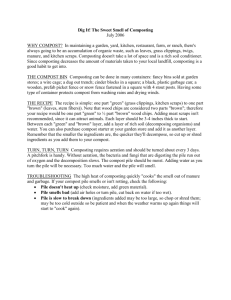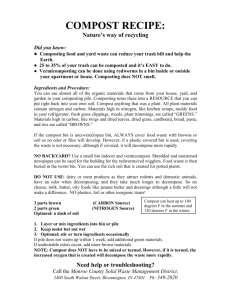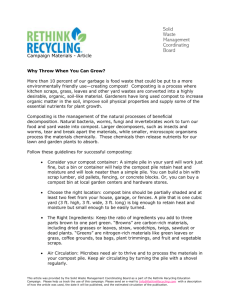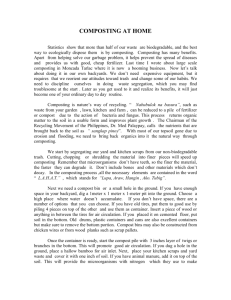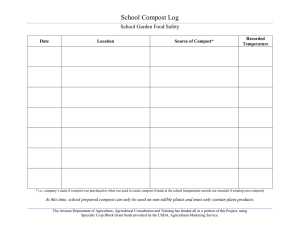Document 11277526
advertisement
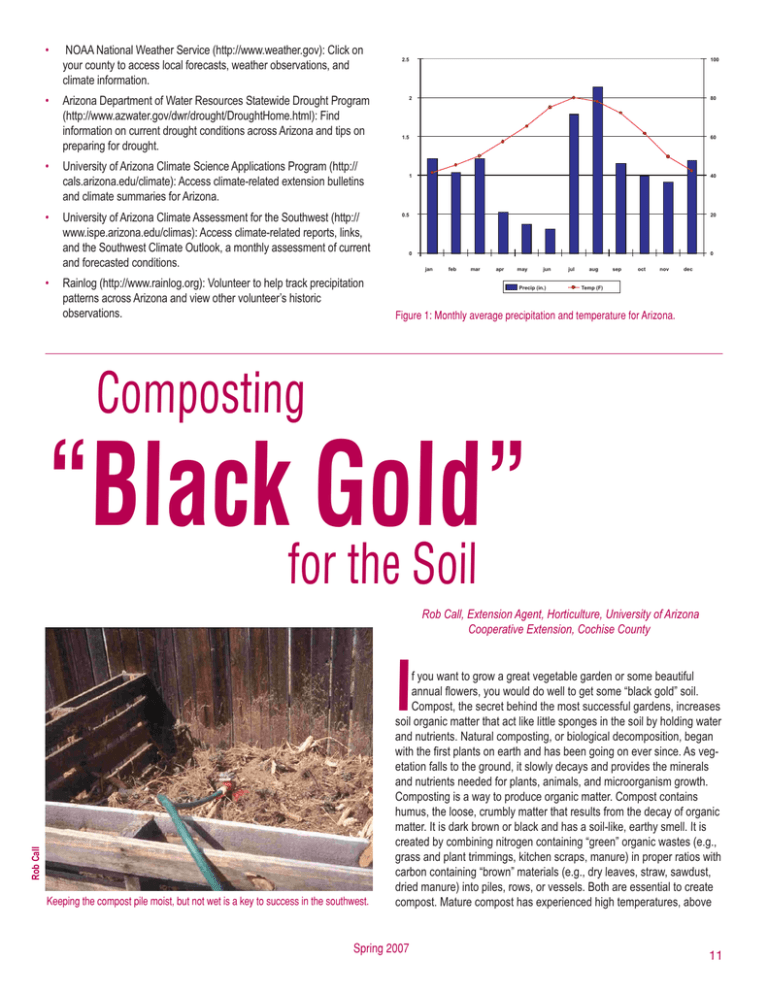
• • • • • NOAA National Weather Service (http://www.weather.gov): Click on your county to access local forecasts, weather observations, and climate information. Arizona Department of Water Resources Statewide Drought Program (http://www.azwater.gov/dwr/drought/DroughtHome.html): Find information on current drought conditions across Arizona and tips on preparing for drought. Rainlog (http://www.rainlog.org): Volunteer to help track precipitation patterns across Arizona and view other volunteer’s historic observations. University of Arizona Climate Science Applications Program (http:// cals.arizona.edu/climate): Access climate-related extension bulletins and climate summaries for Arizona. University of Arizona Climate Assessment for the Southwest (http:// www.ispe.arizona.edu/climas): Access climate-related reports, links, and the Southwest Climate Outlook, a monthly assessment of current and forecasted conditions. " ! &IGURE-ONTHLYAVERAGEPRECIPITATIONANDTEMPERATUREFOR!RIZONA «ÃÌ}Ê º>VÊ`» vÀÊÌ iÊ- Rob Call, Extension Agent, Horticulture, University of Arizona Cooperative Extension, Cochise County Rob Call I +EEPINGTHECOMPOSTPILEMOISTBUTNOTWETISAKEYTOSUCCESSINTHESOUTHWEST f you want to grow a great vegetable garden or some beautiful annual flowers, you would do well to get some “black gold” soil. Compost, the secret behind the most successful gardens, increases soil organic matter that act like little sponges in the soil by holding water and nutrients. Natural composting, or biological decomposition, began with the first plants on earth and has been going on ever since. As vegetation falls to the ground, it slowly decays and provides the minerals and nutrients needed for plants, animals, and microorganism growth. Composting is a way to produce organic matter. Compost contains humus, the loose, crumbly matter that results from the decay of organic matter. It is dark brown or black and has a soil-like, earthy smell. It is created by combining nitrogen containing “green” organic wastes (e.g., grass and plant trimmings, kitchen scraps, manure) in proper ratios with carbon containing “brown” materials (e.g., dry leaves, straw, sawdust, dried manure) into piles, rows, or vessels. Both are essential to create compost. Mature compost has experienced high temperatures, above 3PRING 11 Rob Call 3OMEEXAMPLESOFCOMPOSTCONTAINERS$RUMCOMPOSTERSAIDINAERATION0LASTICCONTAINERSMAYSUNROT 140°F., that eliminate most pathogens and weed seeds that natural decomposition does not destroy. Avoid using animal-based materials and oils when composting. These will attract pests (skunks, cats, dogs and other scavengers) and cause bad smells. • Microorganisms – Periodically add a little native soil to the compost pile. This will inoculate the compost with beneficial microorganisms. These include bacteria, fungi, worms and insects. (Purchase of special composting microbes is not necessary.) Aerobic (air-loving) microbes do the actual decomposing. Creating an environment in which they thrive is the goal. • Oxygen – Air is essential for the organic matter to decompose. Turn the pile frequently, poke deep holes in it, or position the pile a foot or so off the ground to allow for air circulation. Advantages of composting • Composting reduces the dependency on commercial fertilizers and improves soil structure, while adding nutrients needed for healthy plants. It is also inexpensive because you can easily make it with material that would otherwise be thrown away. • Soil pH may be altered by compost addition. Ideal pH for most edible plants and flowers is between 6.0 - 7.0. If the soil is alkaline (over pH 7.5), as much of the arid Southwest is, compost may help lower it over time. • Recycling organic waste materials also reduces landfill use. How to get started • Cost – Composting does not take a lot of time or require much equipment. • Location – The compost pile should be placed in a warm area with adequate sunshine, but out of the wind so it will not dry out too quickly. • Size – An ideal size is one cubic yard (3 feet x 3 feet x 3 feet). If the pile is too small it will decompose slowly. Also, it will not generate and hold enough heat to kill weed seeds and other pests. If the pile is too tall, aeration may not be adequate. • 12 Water – Consistent moisture is important. The pile should contain enough water to feel like a well-wrung out sponge. If the pile is to wet, it may produce unpleasant odors. If it is too dry, decomposition will not occur. Drying out is a major problem for successful composting in the Southwest. The process The first point to remember is that smaller pieces of waste material decompose faster. “Green” and “brown” materials are alternatively layered no more than a foot or two deep. The best material ratio of carbon (brown) to nitrogen (green) is about 25 to 30 parts to 1, respectively. If there is too much brown material in the pile, decomposition will be slow. This can be corrected by adding more green material or some nitrogen fertilizer. If too much green material is present nitrogen may be lost and the pile may smell like ammonia. While layering the two types of material, remember to add some native soil to innoculate the pile with microbes. After the pile is started, wet it thoroughly with water. Monitor moisture over time. Placing a water sprinkler on the pile may aid in keeping the pile moist, but not wet. Turning the pile will aerate it. This will accelerate the decomposition process. Using compost Screen the compost using ¼ - ½” mesh hardware cloth tacked or stapled to the bottom of a box frame made of 1” or 2” x 4” lumber. Place the box on top of a wheel barrow and allow the compost to fall through to produce finished black gold! Return unscreened materials to the compost pile. Add 2 - 4” of finished compost to garden or flower planting areas. Till or turn the soil over with a shovel to incorporate into the soil. Adding too much compost may tie up plant nutrients and stunt plant growth. “Black gold” will increase plant health and growth.


